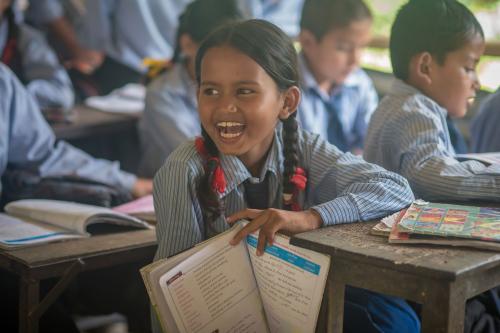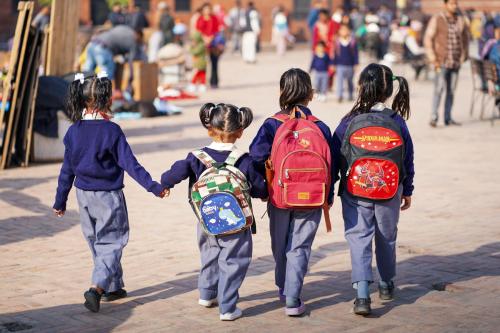Annette was a young girl of 10 when I met her in a refugee camp in southwest Uganda. She had recently fled war in the Democratic Republic of Congo. Surrounded by ongoing fighting in the camp, with not enough to eat, her family torn apart, she retained a bright smile. I soon understood why. “Education will lead me to my dreams for the future,” she told me. Every day, she put on her bright pink uniform and went to school.
Like most refugees, Annette hoped, and truly believed, that she would soon return to her home country. That was until the day her father planted bananas around their compound. Bananas are a long-to-mature crop—you only plant them when you know you will be remaining somewhere for a long time. For most Syrians in exile, the time has come, metaphorically, to plant bananas.
Education is central to the planting of this future.
Refugee children and youth need high quality education that will allow them to be safe and engaged in the present, and enable them to be productive and happy civically and economically in the future. But what will this future be? As educators and parents in any part of the world, we are always imagining the future as we think about what is important for our children to know and understand. We make our best predictions and we follow a path.
No place to go
The unknown future that refugee children and youth face is extreme. The United Nations High Commissioner for Refugees (UNHCR) outlines three durable solutions for refugees: either return to their home country, local integration in the immediate country of exile, or resettlement to a third country such as the United States or Canada. For Amina, a young Syrian refugee living in Lebanon, none of these “solutions” seem all that durable. It is unsafe to return to Syria, life in exile in Lebanon is increasingly precarious, and only 1 percent of refugees globally are resettled.
Amina is one of 2 million Syrian children displaced outside of Syria and 5.6 million children living amid the devastating conflict inside Syria. Most of them see no future in front of them. In Turkey alone, more than 400,000 Syrian children are out of school. Lebanese television last week aired footage of Syrian children being physically beaten in their Beirut schools. More than half of U.S. governors say refugees are simply not welcome.
Despite the uncertainty, Amina wants to go to school. For her, education is the durable solution. Yet the kind of education she receives will determine the future pathways open to her. Decisions about appropriate curriculum, language, and certification all hinge on a conception of what her future will be.
Take the example of Henri. Henri was a Burundian refugee living in exile in Tanzania. When he was in primary school, he studied according to the Tanzanian curriculum in English and Kiswahili. In secondary school, the policy shifted and, all of a sudden, he could only study the Burundian curriculum in French and Kirundi. In his last year of secondary school, his refugee camp was closed and he had to flee to another camp, where he studied the Congolese curriculum in French. When he returned to Burundi, after 18 years of exile, he was hopeful that he could join the university and take part in the reconstruction of his country. There were no educational re-integration programs available to him, no intensive language courses. And without enough fluency in French and no consistency in the curriculum he had followed, he was denied.
Providing a quality education for young refugees
We know what a future denied can lead to—for individuals, for families, for communities. While there is much we cannot know about the future of young Syrian refugees, we must avoid Henri’s educational experiences for contemporary Syrian refugees. To do so, we need to focus on the dimensions of what we do know about the future.
We know that exile is an integral part of a refugee’s future. The average length of exile for refugees is 17 years. That’s the equivalent of a child’s whole shot at education, from birth to high school graduation. With this knowledge, we know that Syrian refugees do not need temporary education programs. They need access to a complete education. Preferably, they need to be fully included in the national education system of the country of refuge.
This inclusive approach is not easy in Istanbul or Beirut, in New York, or Berlin. Imagine one out of four students in your own child’s class recently arrived from a deadly war. But integration in schools reflects what we all seek for our children: stability.
To build a future in the midst of uncertainty, refugee children need teachers who are trained, a well-developed curriculum that builds skills and knowledge, and the possibility of certifying their learning. These elements are more likely to be present in national education systems than in refugee-only schools or temporary programs.
Being physically included in national schools is critical to building strong futures for refugee children. But physical inclusion is only the first step for what really matters: support for learning. Over the past decade, we have uncovered four critical dimensions of this support for refugees’ learning.
Refugee children cannot learn if they are not physically and emotionally safe. Syrian refugee parents describe to us how they fear sending their children to schools due to ongoing physical and emotional bullying. These experiences undermine stability not only for refugees but for national communities. Teachers need training and ongoing support to help refugee and national students understand each other and get along. Globally, this is the number one request from teachers of refugees. This training may seem a luxury, especially in national systems where teachers are trained. It is not. Children who do not feel safe in school cannot learn and quickly become marginalized from their peers and communities.
Refugee children also cannot learn if they don’t know the language. They need intensive language programs before enrolling in national schools and ongoing support through the first few years. I have been in too many classrooms where refugee teenagers cram themselves into tiny benches or sit on the floor in early primary classrooms because that is where language learning happens. This is one quick pathway to drop-out and disillusionment. Digital tools could play an important role in creating language and text-rich environments in the new language—but they are a complement for the relationships that encourage true immersion in a language.
Refugee children’s learning will not lead them to the future they imagine if it is not certified. Most of us probably don’t even know where our diplomas are, yet without recognized certificates of learning, refugees are denied access to education and to the economic opportunities that completion opens up. In northern Kenya, the Borderless Higher Education Consortium, of which I am part, has developed a jointly certified higher education program for Somali refugees, with accreditation through Canadian and Kenyan universities. The intention is to open possibilities for the unknown future. The same is essential for Syrian refugees. No matter where Syrian refugee children continue their education and seek employment in the future, they need to know that their previous learning will be recognized. Support for the creation of educational management systems that can be regionally integrated will be crucial.
Finally, refugee children need to learn through education that they belong, wherever they may be. We are horribly fixated on ideas of belonging that center on the nation-state and rest on exclusion. The conflict in Syria and the resulting refugee crisis is forcing us to confront realities of migration and dilemmas of inclusion that we cannot build walls to fix. While the ultimate future may be unknowable, the current and foreseeable reality is that Syrian children will be in school in exile—and the exclusive national identities often presented to them in history class and social encounters breed resentment and disengagement. Fostering peace amid ethnic and linguistic diversity requires additive national identities that do not ignore the importance of culture and language but reflect contemporary mobility of place and ideas, and of who belongs.
No one flees their home lightly. Families sometimes flee when their physical safety is threatened. Families sometimes flee when their economic livelihoods crumble. Families almost always flee when they can’t imagine a future for their children. And they will continue to move until they can secure that future. In our world, that future is education.
The Brookings Institution is committed to quality, independence, and impact.
We are supported by a diverse array of funders. In line with our values and policies, each Brookings publication represents the sole views of its author(s).




Commentary
For Syrian children and youth, education is the front line
November 20, 2015